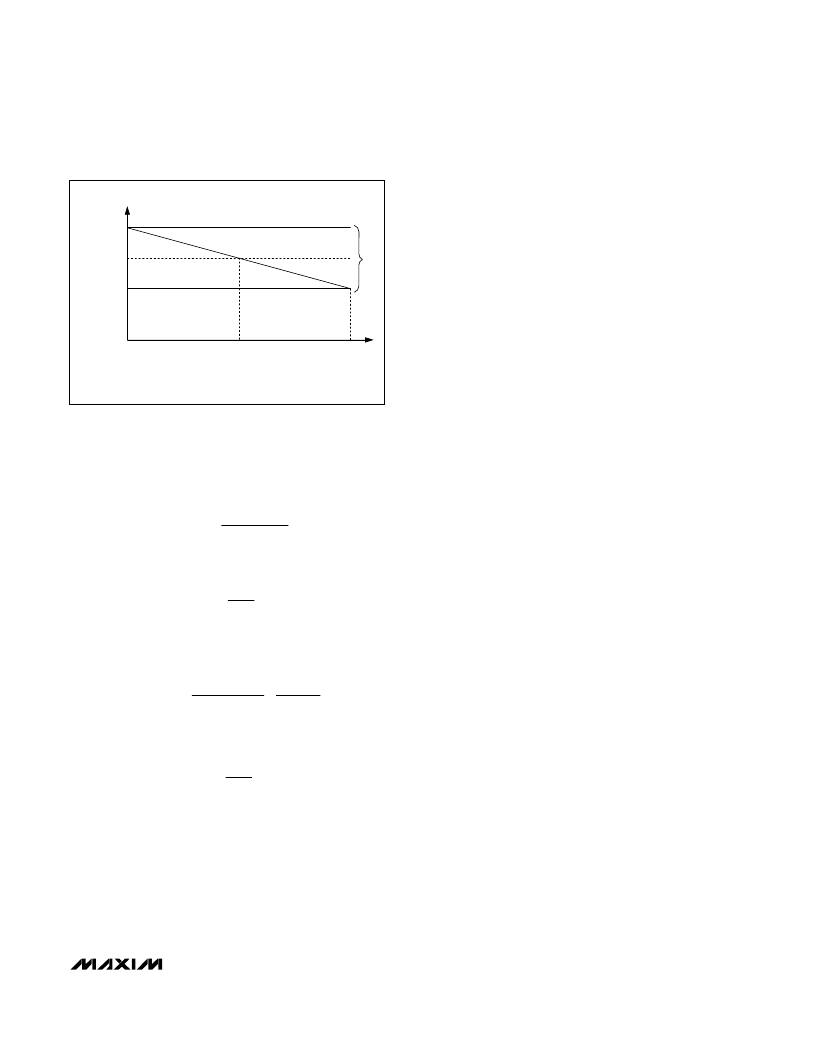- 您現(xiàn)在的位置:買賣IC網(wǎng) > PDF目錄383426 > MAX5038A (Maxim Integrated Products, Inc.) Dual-Phase. Parallelable. Average-Current-Mode Controllers PDF資料下載
參數(shù)資料
| 型號: | MAX5038A |
| 廠商: | Maxim Integrated Products, Inc. |
| 英文描述: | Dual-Phase. Parallelable. Average-Current-Mode Controllers |
| 中文描述: | 雙相、可并聯(lián)、平均電流模式控制器 |
| 文件頁數(shù): | 17/26頁 |
| 文件大小: | 680K |
| 代理商: | MAX5038A |
第1頁第2頁第3頁第4頁第5頁第6頁第7頁第8頁第9頁第10頁第11頁第12頁第13頁第14頁第15頁第16頁當(dāng)前第17頁第18頁第19頁第20頁第21頁第22頁第23頁第24頁第25頁第26頁

M
Dual-Phase, Parallelable, Average-Current-Mode
Controllers
______________________________________________________________________________________
17
Set the voltage-positioning window (
V
OUT
) using the
resistive feedback of the VEA. Use the following equa-
tions to calculate the voltage-positioning window for the
MAX5038A:
Use the following equation to calculate the voltage-posi-
tioning window for the MAX5041A:
where R
IN
and R
F
are the input and feedback resistors of
the VEA, G
C
is the current-loop transconductance, and
R
S
is the current-sense resistor or, if using lossless induc-
tor current sensing, the DC resistance of the inductor.
Phase-Locked Loop: Operation and
Compensation
The PLL synchronizes the internal oscillator to the exter-
nal frequency source when driving CLKIN. Connecting
CLKIN to V
CC
or SGND forces the PWM frequency to
default to the internal oscillator frequency of 500kHz or
250kHz, respectively. The PLL uses a conventional
architecture consisting of a phase detector and a
charge pump capable of providing 20μA of output cur-
rent. Connect an external series combination capacitor
(C25) and resistor (R4) and a parallel capacitor (C26)
from PLLCMP to SGND to provide frequency compen-
sation for the PLL (Figure 1). The pole-zero pair com-
pensation provides a zero at f
Z
defined by 1 / [R4 x
(C25 + C26)] and a pole at f
P
defined by 1 / (R4 x C26).
Use the following typical values for compensating the
PLL: R4 = 7.5k
, C25 = 4.7nF, C26 = 470pF. If chang-
ing the PLL frequency, expect a finite locking time of
approximately 200μs.
The MAX5038A/MAX5041A require compensation on
PLLCMP even when operating from the internal oscilla-
tor. The device requires an active PLL in order to gen-
erate the proper internal PWM clocks.
MOSFET Gate Drivers (DH_, DL_)
The high-side (DH_) and low-side (DL_) drivers drive
the gates of external N-channel MOSFETs (Figures 1
and 2). The drivers
’
high-peak sink and source current
capability provides ample drive for the fast rise and fall
times of the switching MOSFETs. Faster rise and fall
times result in reduced cross-conduction losses. For
modern CPU voltage-regulating module applications
where the duty cycle is less than 50%, choose high-
side MOSFETs (Q1 and Q3) with a moderate R
DS(ON)
and a very low gate charge. Choose low-side MOSFETs
(Q2 and Q4) with very low R
DS(ON)
and moderate gate
charge.
The driver block also includes a logic circuit that pro-
vides an adaptive nonoverlap time to prevent shoot-
through currents during transition. The typical
nonoverlap time is 60ns between the high-side and low-
side MOSFETs.
BST_
V
CC
powers the low- and high-side MOSFET drivers.
Connect a 0.47μF low-ESR ceramic capacitor between
BST_ and LX_. Bypass V
CC
to SGND with 4.7μF and
0.1μF low-ESR ceramic capacitors. For high-current
applications, bypass V
CC
to PGND with one or more
0.1μF, low-ESR ceramic capacitor(s). Reduce the PC
board area formed by these capacitors, the rectifier
diodes between V
CC
and the boost capacitor, the
MAX5038A/MAX5041A, and the switching MOSFETs.
G
R
C
S
=
0 05
.
V
OUT
OUT
I
×
2
IN
R
C
F
H
L
L
R
×
G
R
R
R
=
×
(
)
×
+
G
R
C
S
=
0 05
.
V
I
R
×
G
R
OUT
OUT
×
2
IN
C
F
=
×
LOAD (A)
V
CNTR
NO LOAD
1/2 LOAD
FULL LOAD
V
V
CNTR
+
V
OUT
/2
V
CNTR
-
V
OUT
/2
Figure 5. Defining the Voltage-Positioning Window
(8)
(9)
(10)
(11)
相關(guān)PDF資料 |
PDF描述 |
|---|---|
| MAX5041A | Dual-Phase. Parallelable. Average-Current-Mode Controllers |
| MAX5038AEAI12 | Dual-Phase, Parallelable, Average-Current-Mode Controllers |
| MAX5038AEAI15 | Dual-Phase, Parallelable, Average-Current-Mode Controllers |
| MAX5038AEAI18 | Dual-Phase, Parallelable, Average-Current-Mode Controllers |
| MAX5041BEAI | Low Power 5V RS232 Dual Driver/Receiver with 0.1?μF Capacitors; Package: SO; No of Pins: 16; Temperature Range: -40?°C to 85?°C |
相關(guān)代理商/技術(shù)參數(shù) |
參數(shù)描述 |
|---|---|
| MAX5038AEAI12 | 功能描述:電流型 PWM 控制器 RoHS:否 制造商:Texas Instruments 開關(guān)頻率:27 KHz 上升時(shí)間: 下降時(shí)間: 工作電源電壓:6 V to 15 V 工作電源電流:1.5 mA 輸出端數(shù)量:1 最大工作溫度:+ 105 C 安裝風(fēng)格:SMD/SMT 封裝 / 箱體:TSSOP-14 |
| MAX5038AEAI12+ | 制造商:Maxim Integrated Products 功能描述:- Rail/Tube |
| MAX5038AEAI12-T | 功能描述:電流型 PWM 控制器 RoHS:否 制造商:Texas Instruments 開關(guān)頻率:27 KHz 上升時(shí)間: 下降時(shí)間: 工作電源電壓:6 V to 15 V 工作電源電流:1.5 mA 輸出端數(shù)量:1 最大工作溫度:+ 105 C 安裝風(fēng)格:SMD/SMT 封裝 / 箱體:TSSOP-14 |
| MAX5038AEAI15 | 功能描述:電流型 PWM 控制器 Dual-Phase Parallelable Average RoHS:否 制造商:Texas Instruments 開關(guān)頻率:27 KHz 上升時(shí)間: 下降時(shí)間: 工作電源電壓:6 V to 15 V 工作電源電流:1.5 mA 輸出端數(shù)量:1 最大工作溫度:+ 105 C 安裝風(fēng)格:SMD/SMT 封裝 / 箱體:TSSOP-14 |
發(fā)布緊急采購,3分鐘左右您將得到回復(fù)。